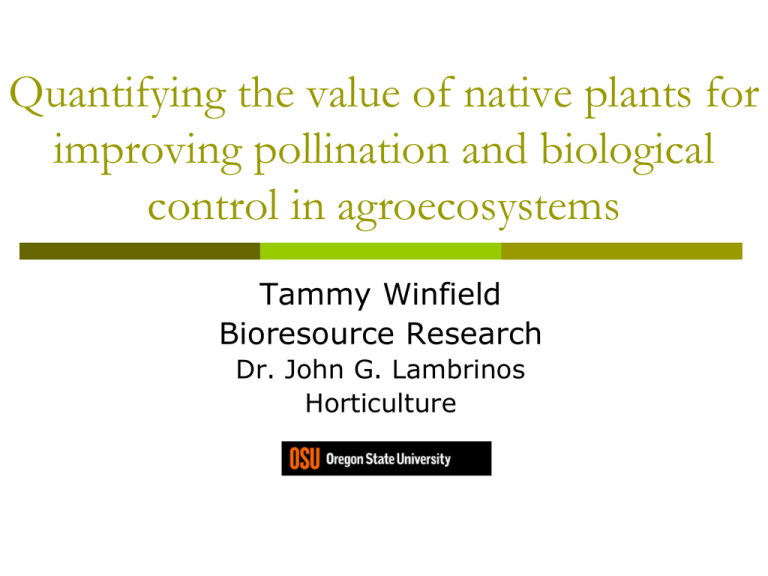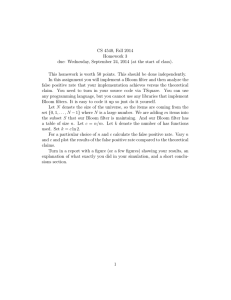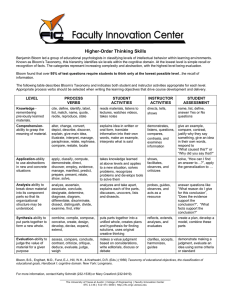Quantifying the value of native plants for improving pollination and biological
advertisement

Quantifying the value of native plants for improving pollination and biological control in agroecosystems Tammy Winfield Bioresource Research Dr. John G. Lambrinos Horticulture Introduction Conservation Biological Control Increase on farm habitat Increase biodiversity Increase pest control and pollination services Added plants offer additional food and shelter Agroecosystems High disturbance Fragmentation Monoculture/low diversity Habitat loss and fragmentation lead to lowered biodiversity and reductions in associated ecosystem services like pollination and biological pest control (Wade et al. 2007). Natural Enemies Parasites or predators of pest insects A regulating ecosystem service Crop protection Increased pest control with decreased pesticides Copyright © 2004 Tom Murrey Save farmers billions of dollars/yr (Naylor and Ehrlich 1997) Pollinators Native bees Provide pollination of crops Copyright © 2008 Tom Bentley Native pollinators value estimated to be in billions of dollars/yr in U.S. (Daily et al. 1997) Copyright © 2005 Steve Scott Copyright © 2007 Cheryl Moorhead Beneficial insects need access to Adult and larval food resources Over wintering habitats Appropriate microclimates Alternate host/ food sources Doutt & Nakata (1973), The principal parasitoid of the grape leafhopper in California grape vineyards required an alternate host for over wintering. Basic knowledge still lacking Resource requirements and preferences of beneficials Insect communities supported by plant species Objectives Quantify the abundance and type of arthropods attracted to native Oregon plants. Quantify the degree to which native plants vary in their relative attractiveness to specific beneficial arthropods. Parasitic wasps and flies, predatory flies and wasps, and native bees Native Plants Achillea millefolium Artemisia ludoviciana Eriophyllum lanatum Erigeron decumbens Eriogonum umbellatum Eriogonum nudum Potentilla gracilis Holodiscus discolor Grindelia integrifolia Aster halliana © 2003 George W. Hartwell (CalPhotos) Methods Field sites National Resource Conservation Service (NRCS) Plant Material Center (PMC) Gathering Together Farm (GTF) 3415 NE Granger Ave, Corvallis 25159 Grange Hall Rd. Philomath Heavenly Harvest (HH) 5757 HWY 20, Corvallis On farm plants: Achillea millefolium, Erigeron decumbens, and Eriophyllum lanatum Assess insect associates in an agricultural environment vs. PMC Sampling methods Arthropod Three randomly selected 1 m2 section/block Vacuum Craftsman leaf blower/vac 10 sec/section Pan traps White/ fluorescent blue / fluorescent yellow One of each color 5m apart/block Plant phenology Phenology is the study of the annual cycles of plants and animals and how they respond to seasonal changes in their environment Count open flowers Three permanent 1 m2 section/block Outcomes Quantitative information on native Oregon plants that might be good choices for conservation biological control and increased pollination services. Plant material that is currently being developed for broad conservation and restoration use by the PMC. Phenology Results June Week 3 4 July 1 2 August 3 4 Artemisia ludoviciana ■ ▌ ■ ▬▬▬ Eriophyllum lanatum ■ ▌ ■ ▬▬▬ Potentilla gracilis ■ ▌ ▬▬▬ Holodiscus discolor ▬■ ▌■ ▬▬ Eriogonum umbellatum ▬■ ▌■ ▬▬ Eriogonum nudum ▬■ ▌■ ■ Erigeron decumbans ▬■ ▌▬▬▬ Achillea millefolium ▬■ ▌■ ■ ▬ 1 2 3 September 4 1 2 3 4 ▬▬▬▬▬ ■ ▬▬▬▬▬ ▬▬ ▬▬▬▬ Grindelia integrifolia ▬ ■ ■ ■ ■ ■ ▌ Aster halliana ▬ ▬▬▬ ■ ■ ■▌ ▌Peak bloom= date of maximum bloom ■Full Bloom= weeks either side of peak bloom date with 50% or more of peak bloom ▬In Bloom= Weeks either side of full bloom with less than 50% of peak bloom Arthropod Collection Results Approximately 200 vials full of insects to ID yet! m ille fo li lu do u m vic ia E. La na E. n de atu m c E. um um ba be ns lla E. tum nu d P. um gr a H. cili di s A. sco lo su r k sd G .i n t or fi eg i ri A. fo li ha a llia na A. A. Mean Arthropods Plans for data analysis A Hypothetical example 50 45 40 35 30 25 20 15 10 5 0 Natural enemies Pests Pollinators Plant Species Table 1. Proportion of total natural enemies collected at all flowering plants by order and family Order Family Number Percent Total Hemiptera Anthrocoridae Nabidae ? ? Coleoptera Carabidae ? ? Hymentoptera Braconidae Chalcidoidea vespidae ? ? Diptera Bombylidae Syrphidae ? ? Thysanoptera Aeolothirpidae ? ? Future Research Directions Project continuation Start earlier in growing season Add more plants Possible projects on habitat patch size and diversity Plots of various sizes and species compositions Optimum spacing of patches How far will arthropods move from a patch into the crop to pollinate or find hosts/prey Biocontrol with small patch size? Yards and gardens Acknowledgments The Ernest and Pauline Jaworski Fund URISC Dr. John Lambrinos HHMI summer program Dr. Kevin Ahern Gwendolyn Ellen Integrated Plant Protection Center Heavenly Harvest Farm Gathering Together Farm Amy Bartow and Joe Williams National Resource Conservation Service Plant Material Center THANK YOU! http://www.ipmnet.org/Beneficial_Insects_Draft5.pdf


